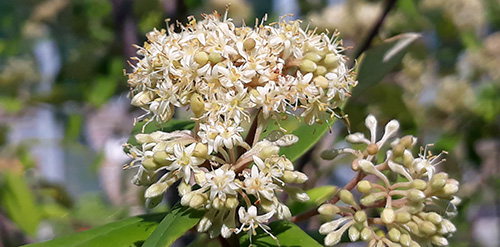Key stats:
- Status: Critically Endangered.
- 200+ plants have been replanted into wild sites (more than tripling naturally occurring wild numbers)
- Approximately 100 plants are held in ex-situ collections at Wollongong Botanic Garden, constantly under propagation.

Carrington Falls Pomaderris (Pomaderris walshii) is a critically endangered plant and is endemic to NSW - that means it's only found growing here and nowhere else in the world. There are only about 80 individuals growing in the wild in and around Budderoo National Park. In the wild there is an extremely low rate of new seedlings growing up in the understory.
NSW National Parks and Wildlife Service has been working with this critically threatened species for almost 20 years. In 2015, Wollongong Botanic Garden joined efforts to protect this plant, working with NSW National Parks and Wildlife and the Office of Environment and Heritage / Department of Industry Planning and Environment, and with support from the Saving Our Species Program.
Our team collected cuttings to build an ex-situ collection (one that is outside its natural population). Having an ex-situ conservation collection allows us to create a 'back up' for this species. This could be important if anything goes wrong with the wild population, like a fire or major flood. This species has a very small natural range, so a major flood or fire could devastate the whole species in the wild. In the last few years there have been a few floods which have caused a lot of damage to the wild population, highlighting the importance of having back up ex-situ holdings.
Our ex-situ collection also supports research projects, which means researchers do not have to access or damage the wild population to get samples to work on. Research carried out with this species from ex-situ holdings included genetic research to understand how diverse and ‘healthy’ this small population is. Other research includes how the seeds respond to fire, and whether this species has evolved to withstand fire. This can help us understand if other treatments can support this species to naturally regenerate in the wild, like small controlled burns or similar measures.
Since we've been propagating this species, we've added a few hundred to our ex-situ holdings. In November 2018, more than 100 of these were replanted into the wild in eight different locations to test ideal planting conditions. This data helped inform future re-introductions of this species. In August 2019 another 100+ plants went out into the wild, effectively tripling the wild population across these two plantings.
All this work is being done to safeguard this critically endangered species into the future. This project is a great example of different organisations working together to get positive conservation outcomes.
